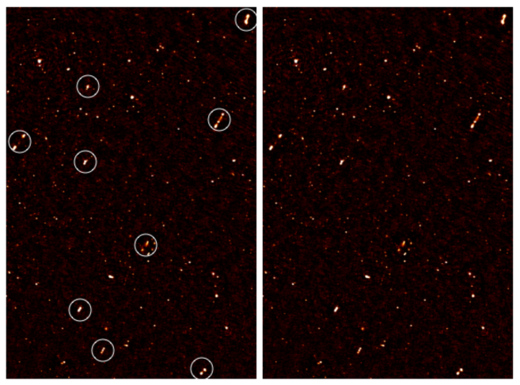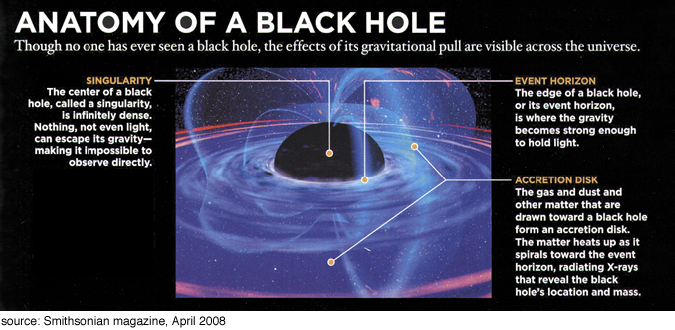| Topic: Why are the jets of these supermassive black holes aligned? | |
|---|---|

A deep radio map covering the ELAIS-N1 region with aligned galaxy jets circled in white in the image on the left. Jets blasting from 64 supermassive black holes in a distant patch of the Universe appear to be lined up, like needles on compasses In a distant patch of the Universe has emerged a mysterious phenomenon: the jets blasting from the centre of 64 supermassive black holes in galaxies are all aligned. Three years of radio images snapped by the Giant Metrewave Radio Telescope in India and analysed by a pair of astronomers in South Africa picked up the faint signatures of jets pointing in the same direction like compass needles, and may give clues about the structure of the primordial Universe when the black holes formed. "Since these black holes don't know about each other, or have any way of exchanging information or influencing each other directly over such vast scales, this spin alignment must have occurred during the formation of the galaxies in the early Universe," says study co-author Russ Taylor from the University of the Western Cape. The aligned jets were found in the European Large-Area ISO Survey-North 1 (ELAIS-N1) region of the sky and published in the Monthly Notices of the Royal Academy of Sciences. When Taylor and co-author Preshanth Jagannathan, who was at the University of Cape Town at the time but is now at the National Radio Astronomy Observatory in New Mexico, US, spotted the aligned jets, they calculated the odds of chance alignment to be less than 0.1%. So what was going on? The direction of a jet, they write, is determined by the angular momentum axis of the spinning supermassive black hole powering it. Given a whole bunch of jets are aligned in ELAIS-N1, it follows that their black holes are spinning with the same angular momentum too - so something must've set them going when the Universe was young and the black holes forming. There are a few ways this may have happened. A massive cosmic magnetic field, exotic particles or cosmic strings - theoretical "fault lines" in the Universe - may have set the black holes spinning the same way. Or something else entirely - Taylor and Jagannathan don't know. More imaging projects are in the pipeline to examine even fainter galaxies in ELAIS-N1, using the Australian SKA Pathfinder and South African MeerKAT array, and eventually, the Square Kilometre Array (SKA), which is scheduled for construction in Western Australia and South Africa. "[The Giant Metrewave Radio Telescope] is one of the largest and most sensitive radio telescope arrays in the world, but we really need MeerKAT to make the very sensitive maps, over a very large area and with great detail, that will be necessary to differentiate between possible explanations," Taylor says. "It opens up a whole new research area for these instruments, which will probe as deeply into the [past] and as far back as we can go." Belinda Smith is Cosmos deputy news editor. Comment: The Electric Universe theory has already provided a plausible explanation of the alignment of of quasars. Perhaps it can also be extended to black holes? Electric universe? "Spooky" alignment of quasars across billions of light-years http://cosmosmagazine.com/space/why-are-these-supermassive-black-holes-aligned |
|
|
|
|
|
If they were all formed from the same rotating disc of matter, they would be expected to line up just like the axis of the spinning planets in our Solar System mostly line up. Some of our planets have had the crap knocked out of them by other planets but not much can knock the crap out of a supermassive black hole.
|
|
|
|
|
|
If they were all formed from the same rotating disc of matter, they would be expected to line up just like the axis of the spinning planets in our Solar System mostly line up. Some of our planets have had the crap knocked out of them by other planets but not much can knock the crap out of a supermassive black hole. makes sense, there is a lot of mass involved there... maybe some sort of quantum action? or maybe gravity itself makes them all spin the same way... |
|
|
|
|
|
Okay, 'splain me why these can be seen, these jets?
When everything around a black hole absorbs light? Is it some kind of spinning..friction that we see? |
|
|
|
|
|
Edited by
mightymoe
on
Wed 04/13/16 11:05 PM
|
|
|
Okay, 'splain me why these can be seen, these jets? When everything around a black hole absorbs light? Is it some kind of spinning..friction that we see? i've always wondered that myself... i have no answer here is a pic in the visible spectrum of a jet...(most are artist conceptions of what they look like) 
they can travel for 100's of light years away from the black hole... 
|
|
|
|
|
|
Okay, 'splain me why these can be seen, these jets? When everything around a black hole absorbs light? Is it some kind of spinning..friction that we see? Exactly ... spinning friction. What happens is that dust, gas, planets, even other stars, fall into the gravity field of a supermassive black hole but typically do not dive straight at it's center. As the falling objects fall in with tighter and tighter orbits with higher and higher velocities (scientifically, this is called conservation of angular momentum), they start to rub on each other and the friction creates heat. The objects can reach a significant percentage of the speed of light and the heat generated by friction is in the millions of degrees. At this point, the matter emits gamma rays which heat up anything they strike making the jet visible. None of this matter has yet to enter the event horizon of the black hole. It is just orbiting at extreme velocity. Matter must get close enough to the black hole to warp space/time in excess of the speed of light for things to "go black". This distance from the center of the black hole is known as the event horizon. Nothing that gets closer, not even light, to the black hole can escape because space itself is falling into the black hole faster than the speed of light. |
|
|
|
|
|
Thanks, makes sense.
When you say "..because space itself is falling into the black hole faster than the speed of light." I am trying to figure how this relates to when we see it in real time? If the hole is say billions of years old, but enlarging faster than light travels, can our universe have been.. swallowed long ago? |
|
|
|
|
|
Thanks, makes sense. When you say "..because space itself is falling into the black hole faster than the speed of light." I am trying to figure how this relates to when we see it in real time? If the hole is say billions of years old, but enlarging faster than light travels, can our universe have been.. swallowed long ago? That's a little bit "apples and oranges".  Gravity warps Gravity warps
time and space. The closer you get to the black hole the slower time operates from the view of an observer (relativity). When light can't get away from the gravity source due to space warping, you don't see anything anymore. This is the black part. The actual gravity source (the singularity) is infinitely small. The Black Hole (event horizon) is just the zone of intense gravity that warps space. Therefore, all the events that occur in the heavily warped space near the singularity are invisible to us. The visible jets, accretion disc, and glowing gas, are all outside that zone and operate in space normal enough for things to be visible. The "hole" doesn't enlarge faster than the speed of light. In fact, the singularity doesn't enlarge at all. The event horizon enlarges proportional to the amount of mass it swallows. Current theory is that primordial black holes were formed by a huge cloud of gas that did not need a star to collapse. Galaxies could then have formed around them. 
A feeding black hole emits the jet. 
|
|
|
|
|








